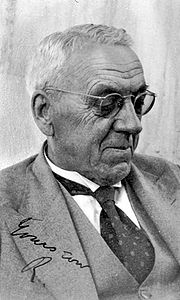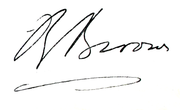
Robert Broom
Encyclopedia


South Africa
The Republic of South Africa is a country in southern Africa. Located at the southern tip of Africa, it is divided into nine provinces, with of coastline on the Atlantic and Indian oceans...
n doctor and paleontologist. He qualified as a medical practitioner in 1895 and received his DSc
DSC
-in academia:* D.Sc., Doctor of Science* Doctor of Surgical Chiropody, superseded in the 1960s by Doctor of Podiatric Medicine* Dalton State College, Georgia* Daytona State College, Florida* Deep Springs College, California* Dixie State College of Utah...
in 1905 from the University of Glasgow
University of Glasgow
The University of Glasgow is the fourth-oldest university in the English-speaking world and one of Scotland's four ancient universities. Located in Glasgow, the university was founded in 1451 and is presently one of seventeen British higher education institutions ranked amongst the top 100 of the...
. In 1893 he married Mary Baird Baillie.
From 1903 to 1910 he was professor of zoology and geology at Victoria College
Stellenbosch University
Stellenbosch University is a public research university situated in the town of Stellenbosch, South Africa. Other nearby universities are the University of Cape Town and University of the Western Cape....
, Stellenbosch
Stellenbosch, Western Cape
Stellenbosch is a town in the Western Cape province of South Africa, situated about east of Cape Town, along the banks of the Eerste Rivier. It is the second oldest European settlement in the province, after Cape Town...
, South Africa, and subsequently he became keeper of vertebrate paleontology
Vertebrate paleontology
Vertebrate paleontology is a large subfield to paleontology seeking to discover the behavior, reproduction and appearance of extinct animals with vertebrae or a notochord, through the study of their fossilized remains...
at the South African Museum, Cape Town
Cape Town
Cape Town is the second-most populous city in South Africa, and the provincial capital and primate city of the Western Cape. As the seat of the National Parliament, it is also the legislative capital of the country. It forms part of the City of Cape Town metropolitan municipality...
.
Contributions
Broom was first known for his study of mammal-like reptiles. After Raymond DartRaymond Dart
Raymond Arthur Dart was an Australian anatomist and anthropologist, best known for his involvement in the 1924 discovery of the first fossil ever found of Australopithecus africanus, an extinct hominid closely related to humans, at Taung in the North of South Africa in the province...
's discovery of the Taung Child
Taung Child
The Taung Child — or Taung Baby — is the fossilized skull of a young Australopithecus africanus individual. It was discovered in 1924 by quarrymen working for the Northern Lime Company in Taung, South Africa...
, an infant australopithecine, Broom's interest in paleoanthropology was heightened. Broom's career seemed over and he was sinking into poverty, when Dart wrote to Jan Smuts
Jan Smuts
Jan Christiaan Smuts, OM, CH, ED, KC, FRS, PC was a prominent South African and British Commonwealth statesman, military leader and philosopher. In addition to holding various cabinet posts, he served as Prime Minister of the Union of South Africa from 1919 until 1924 and from 1939 until 1948...
about the situation. Smuts exerting pressure on the South African government, managed to obtain a position for Broom, in 1934 with the staff of the Transvaal Museum
Transvaal Museum
""The Ditsong National Museum of Natural History, formerly Transvaal Museum, is a natural history museum situated in Pretoria, South Africa....
in Pretoria
Pretoria
Pretoria is a city located in the northern part of Gauteng Province, South Africa. It is one of the country's three capital cities, serving as the executive and de facto national capital; the others are Cape Town, the legislative capital, and Bloemfontein, the judicial capital.Pretoria is...
as an Assistant in Palaeontology.
In the following years, he and John T. Robinson made a series of spectacular finds, including fragments from six hominids in Sterkfontein
Sterkfontein
-References:-References:-References:: : : :...
, which they named Plesianthropus transvaalensis, popularly called Mrs. Ples
Mrs. Ples
Mrs. Ples is the popular nickname for the most complete skull of an Australopithecus africanus specimen ever found in South Africa. Many fossils of this species, which are considered to be the distant relatives of all humankind, have been found in the Sterkfontein area, in what has been designated...
, but which was later classified as an adult Australopithecus africanus
Australopithecus africanus
Australopithecus africanus was an early hominid, an australopithecine, who lived between 2–3 million years ago in the Pliocene. In common with the older Australopithecus afarensis, A. africanus was slenderly built, or gracile, and was thought to have been a direct ancestor of modern humans. Fossil...
, as well as more discoveries at sites in Kromdraai and Swartkrans
Swartkrans
Swartkrans is a location in South Africa, around from Johannesburg.Swartkrans is a farm near to Sterkfontein, notable for being extremely rich in archaeological material, particularly hominid remains. It was purchased by the University of the Witwatersrand in 1968...
. In 1937, Broom made his most famous discovery of Paranthropus robustus
Paranthropus robustus
Paranthropus robustus was originally discovered in Southern Africa in 1938. The development of P. robustus, namely in cranial features, seemed to be aimed in the direction of a "heavy-chewing complex"...
. These discoveries helped support Dart's claims for the Taung species.
The remainder of Broom's career was devoted to the exploration of these sites and the interpretation of the many early hominid remains discovered there. For his volume, The South Africa Fossil Ape-Men, The Australopithecinae, in which he proposed the Australopithecinae subfamily, Broom was awarded the Daniel Giraud Elliot Medal
Daniel Giraud Elliot Medal
The Daniel Giraud Elliot Medal is awarded by the U.S. National Academy of Sciences "for meritorious work in zoology or paleontology published in a three- to five-year period." Named after Daniel Giraud Elliot, it was first awarded in 1917....
from the National Academy of Sciences
United States National Academy of Sciences
The National Academy of Sciences is a corporation in the United States whose members serve pro bono as "advisers to the nation on science, engineering, and medicine." As a national academy, new members of the organization are elected annually by current members, based on their distinguished and...
in 1946. He continued to write to the very last. Shortly before his death he finished a monograph on the Australopithecines and remarked to his nephew:
-
- "Now that's finished ... and so am I."
Spiritual evolution
Broom was a nonconformist and was deeply interested in the paranormalParanormal
Paranormal is a general term that designates experiences that lie outside "the range of normal experience or scientific explanation" or that indicates phenomena understood to be outside of science's current ability to explain or measure...
and spiritualism
Spiritualism
Spiritualism is a belief system or religion, postulating the belief that spirits of the dead residing in the spirit world have both the ability and the inclination to communicate with the living...
, he was a critic of Darwinism
Darwinism
Darwinism is a set of movements and concepts related to ideas of transmutation of species or of evolution, including some ideas with no connection to the work of Charles Darwin....
and materialism
Materialism
In philosophy, the theory of materialism holds that the only thing that exists is matter; that all things are composed of material and all phenomena are the result of material interactions. In other words, matter is the only substance...
. Broom was a believer in spiritual evolution
Spiritual evolution
Spiritual evolution is the philosophical, theological, esoteric or spiritual idea that nature and human beings and/or human culture evolve, extending from the established cosmological pattern or ascent, or in accordance with certain pre-established potentials...
. In his book The Coming of Man: Was it Accident or Design? (1933) he claimed that "spiritual agencies" had guided evolution
Evolution
Evolution is any change across successive generations in the heritable characteristics of biological populations. Evolutionary processes give rise to diversity at every level of biological organisation, including species, individual organisms and molecules such as DNA and proteins.Life on Earth...
as animals and plants were too complex to have arisen by chance. According to Broom, there were at least two different kinds of spiritual forces, and psychics are capable of seeing them. Broom claimed there was a plan and purpose in evolution and that the origin of Homo sapiens is the ultimate purpose behind evolution. According to Broom "Much of evolution looks as if it had been planned to result in man, and in other animals and plants to make the world a suitable place for him to dwell in.
After discovering the skull of Mrs. Ples
Mrs. Ples
Mrs. Ples is the popular nickname for the most complete skull of an Australopithecus africanus specimen ever found in South Africa. Many fossils of this species, which are considered to be the distant relatives of all humankind, have been found in the Sterkfontein area, in what has been designated...
, Broom was asked if he excavated at random, Broom replied that spirits had told him where to find his discoveries.
Publications
Among hundreds of articles contributed by him to scientific journals, the most important include:- "Fossil Reptiles of South Africa" in Science in South Africa (1905)
- "Reptiles of Karroo Formation" in Geology of Cape Colony (1909)
- "Development and Morphology of the Marsupial Shoulder Girdle" in Transactions of the Royal Society of Edinburgh (1899)
- "Comparison of Permian Reptiles of North America with Those of South Africa" in Bulletin of the American Museum of Natural History (1910)
- "Structure of Skull in Cynodont Reptiles" in Proceedings of the Zoölogical Society (1911).
- The South Africa Fossil Ape-Men, The Australopithecinae (1946).
Books
- The origin of the human skeleton: an introduction to human osteology (1930)
- The mammal-like reptiles of South Africa and the origin of mammals (1932)
- The coming of man: was it accident or design? (1933)
- The South African fossil ape-man: the Australopithecinae (1946)
- Sterkfontein ape-man Plesianthropus (1949)
- Finding the missing link (1950)
See also
- List of fossil sites (with link directory)
- List of hominina (hominid) fossils (with images)
- Bernard Price Institute for Palaeontological ResearchBernard Price Institute for Palaeontological ResearchThe Bernard Price Institute for Palaeontological Research is part of the School of Geosciences in the Faculty of Science of the University of the Witwatersrand, Johannesburg, South Africa...
External links
- http://www.talkorigins.org/faqs/homs/rbroom.htmlBiographies: Robert Broom TalkOrigins ArchiveTalkOrigins ArchiveThe TalkOrigins Archive is a website that presents mainstream science perspectives on the antievolution claims of young-earth, old-earth, and "intelligent design" creationists...
] - Robert Broom: A Short Bibliography of his Evolutionary Works, MPRInstitute.org site.
- British metaphysics as reflected in Robert Broom's evolutionary theory, translation of an article by Václav Petr published in Bulletin of the Czech Geological Survey, 75(1): 73-85. Praha 2000. Text and photos displayed entire at the MPRInstitute.org site.

